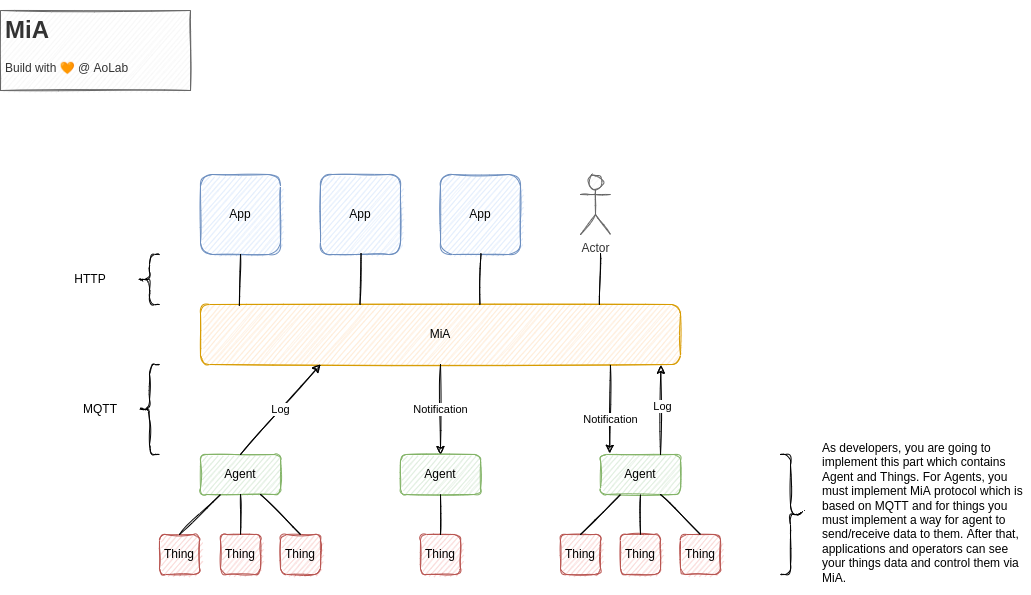IoT Platform PoC
Middleware connects different, often complex and already existing programs that were not originally designed to be connected.
MiA provides you a full featured package that can do all you need from IoT middleware (Platform) consist of create notification, collect logs and discover and manage your things.
In MiA literature you have things and agents, things are your actuators and sensors and agents are any device that can connect to the MiA server, they only requirement is being able to make MQTT requests. An examples of such devices are NodeMCU and RPi.
The benefits we can point out about MiA are:
- SDK pain is over, you don't need sdk's anymore!
- Minimalistic dependencies, you're node only should be able to make MQTT requests
- Dead simple sample codes
- You can deploy it over your personal PaaS for mission-critical security or high-availability purposes
MiA provides following components of IoT Application Enablement Platform:
- Connectivity & normalization
- Device management
- Database
- Processing & action management
- Data visualization
firs of all you can start the database and mqtt broker (the only requirements for MiA) by provided docker-compose as below:
docker-compose up -dif you have any issue with docker or docker-compose you can install these dependency based on their official manual. For MongoDB please check here and for EMQX please check here.
then you can run MiA with pipenv as follow:
pipenv install
pipenv run main.pyAlso you can the simple dummy agent to check that MiA is up and running:
pipenv run dummy.py
if you are a fan of docker, you can run MiA in docker:
docker run -e MIA_MQTT__HOST=lhar -ti ghcr.io/i1820/mia:latest
MiA supports both file-based and env-based configuration so you can use which one that suites you.
You can use the following reuqest to see the latest data for the given thing.
Please note that in MiA things are uniqued with their thing_id and agent_id.
curl -X POST 127.0.0.1:8080/things -H 'Content-Type: application/json' -d '{
"agent_id": "dummy",
"device_id": "0",
"type": "dummy",
"states": ["chert"]
}'For changing settings on a thing we have the following request:
curl -X PUT 127.0.0.1:8080/things -H 'Content-Type: application/json' -d '{
"agent_id": "dummy",
"device_id": "1",
"type": "lamp",
"settings": { "on": true }
}'Also with the following request you can see the registered agents:
curl 127.0.0.1:8080/agentsWant to know more?
http://127.0.0.1:8080/docs
http://127.0.0.1:8080/docs/swaggerAn agent gather things's data and controls them. Each agent periodically pings the MiA server, so it can find out the agent is up and running and also knows about its current number of active things. Each ping is a message which is sent over MQTT with the following JSON structure and to I1820/{TENANT_ID}/agent/ping topic.
"id": "a-very-unique-id",
"things": [
{ "id": "t1", "type": "lamp" },
],
"actions": []id is a unique identification of the agent, and it must be set on the agent side (MiA is not a production ready IoT platform, and this is one of its issues). things is a list of the active and attached things to the agent. There are no restrictions on how the agent communicate with the things, so you can use SPI, I2C, nRF, Wi-Fi, etc.
Each thing has its id but this ID and its agent ID together will unique the thing, so you can use the same ID over things that are connected to the different agents. Things also has type, type specify the things capabilities like what it reports, what it controls etc. Types that are used for things must be defined in MiA and this happens with python files that are here.
Types in the IoT world are very important and there are plenty of things out there so MiA tries its best on the type system which is written in python and without even a restart you can add your types into MiA.
After the ping functionality agent must have a way for sending the things data into the MiA server. This happens with the following json structure that is sending over MQTT to I1820/{TENANT_ID}/log/send topic.
{
"timestamp": 1653572066,
"type": "temperature",
"device": "t1",
"states": [{ "name": "temperature", "value": 10.2 }],
"agent": "a-very-unique-id"
}Each log contains agent which is the agent ID and device which is a thing ID. Again type specify the thing type and states contains the thing states which is defined in its type here. timestamp is the time that this log is captured .
MiA tries its based on be multi-tenant this means you can run multiple MiA servers over one MQTT broker to aggerate data from multiple rooms for example. To have this functionality each MiA server starts with a uniqe Tenant ID which is used over its MQTT topics. The default value for the Tenant ID is main so when you want only one MiA server use main instead of {TENANT_ID}.
At the end we need to configure the things for example we want to turn on the lamp and on is a configuration or setting on the lamp as a thing. For this we need to subscribe on I1820/{TENANT_ID}/configuration/request in agents. Each message on this topic which comes from MiA server has the following structure in json.
{
"type": "lamp",
"device": "l1",
"settings": [{ "name": "on", "value": true }],
"agent": "a-very-unique-id"
}Each configuration message (here we called them notification) contains agent which is the agent ID and device which is a thing ID. Again type specify the thing type and settings contains the thing settings which is defined in its type here.
This platform started as PoC on AoLab (Summer 2016) when we have many trobble with Kaa as our IoT Platform. Our goals were minimizing the resource usage and having a dynamic type system. We used this PoC on Computer Engineering Facility of Amirkabir University of Engineering when we were going to have smart room e2e IoT solution.
After that we planned for having a better and more scalable solution which useful for other IoT verticals beside the smart building and then I1820 borned.






